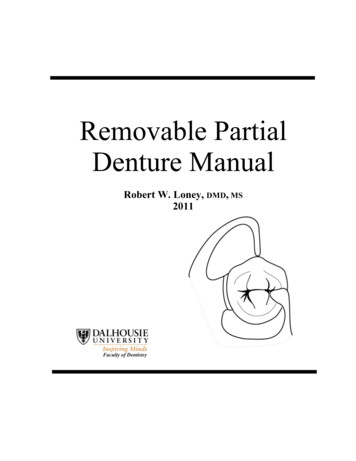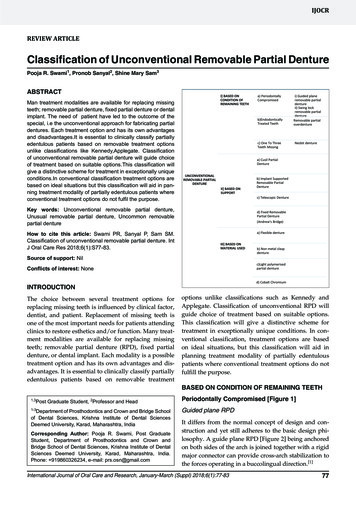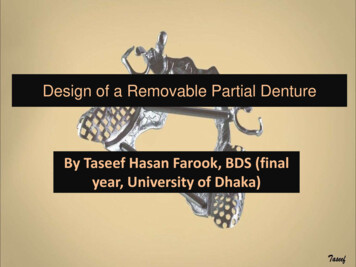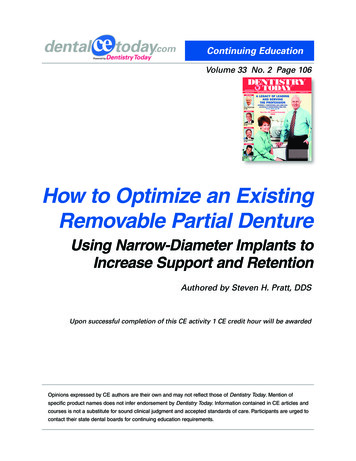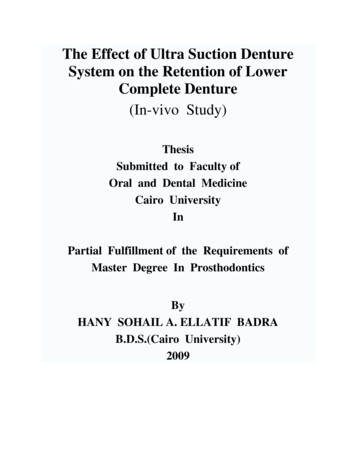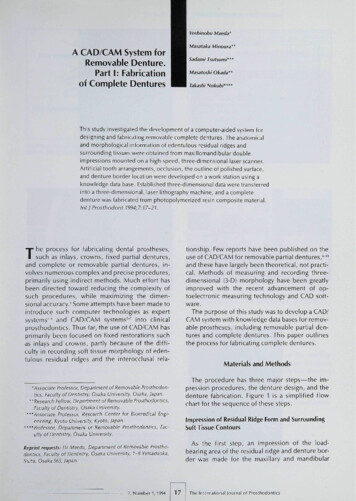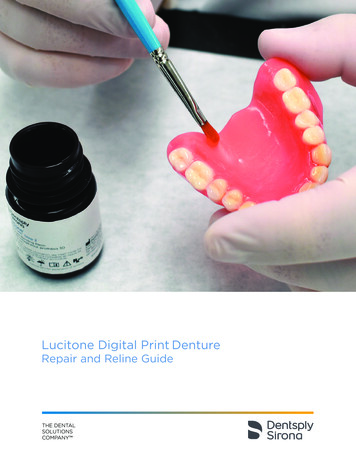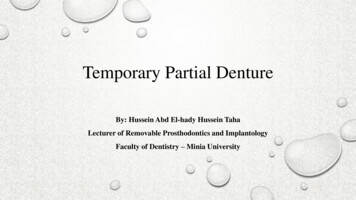
Transcription
Temporary Partial DentureBy: Hussein Abd El-hady Hussein TahaLecturer of Removable Prosthodontics and ImplantologyFaculty of Dentistry – Minia University
TEMPORARY REMOVABLE PARTIAL DENTURES Removable partial dentures that are designed to be used for shortintervals and considered as a part of a total prosthodontictreatment.
TEMPORARY REMOVABLE PARTIAL DENTURES An acrylic RPD consist of an acrylic resin denture base , artificialteeth, and wrought wire clasp or even cast clasps.
Indications: Appearance. Space Maintenance. Re-establishing occlusal relationships. Conditioning teeth and residual ridges. An interim restoration during treatment. Conditioning the patient for wearing a prosthesis. When cost is a prime requisite. Children - permanent prosthesis would be quickly outgrown Temporary space maintenance (caries, trauma, congenitally missing teeth)
Treatment DentureTissue conditioning
Treatment DentureImplant healing
EXPECTED TOOTH LOSS
NIGHT GUARD
CHEAPER ALTERNATIVE GOOD APPEARANCE EASY TO CONSTRUCT IN LAB EASY TO REPAIR AND RELINE POOR THERMAL CONDUCTIVITY RELATIVELY BULKY LOW IMPACT STRENGTH (FRACTURE LACK OF IDEAL SUPPORT(GUM STRIPPING)
TYPES of temporary partial denture1.Interim partialdenture young patient Diagnostic2. Transitionalpartial denture expected toothloss Immediatedenture3-Treatment acrylicpartial denture Cost Ttt for oral tissueabused Splinting Night guard Geriatric orelderly patients
TYPES of temporary partial dentureA) Interim partial denture It is designed to enhance esthetics, stabilization and/or function for a limitedperiod of time. It is usually made of acrylic resin with wrought wire clasps. It may beindicated when age and time factors may prohibit the construction of thedefinitive prosthesis.
TYPES of temporary partial dentureB) Transitional removable partial denture This is a removable partial denture serving as an interim prosthesis to whichartificial teeth will be added as will be replaced by the definitive prosthesisafter tissue changes have occurred. It may become an interim completedenture when all natural teeth have been removed from the dental arch.
TYPES of temporary partial dentureC) Treatment removable partial denture It is another form of interim prosthesis that is used for the purpose of treatingor conditioning the tissues.
The all acrylic RPD They consist of an acrylic denture base, artificial teeth and wroughtwire clasps or cast clasps. They are indicated for all the same reasonsmentioned for the temporary RPD.
Advantages Less expensive than skeleton RPD. Light in weight. Simpler in design and easily constructed. A lost natural tooth can be easily added. Easily repaired and relined. Provides good esthetics and provides good labial and buccal support. Easily adjusted.
Disadvantages Lower strength than metallic framework, and so it must beconstructed in thicker sections. Less patient tolerance. Poor thermal conductivity. Tendency for warpage. Does not provide tooth support or indirect retention when needed.
Spoon denture It is mucosa borne acrylic RPD without clasps that replaces missing maxillaryanterior teeth.Dentures whose retention depends primarily on control by the patient’smusculature.
Spoon denture Design for the replacement of one or two anterior teeth in young people isthe. It reduces gingival margin coverage to a minimum, but a potentialhazard is the risk of inhalation or ingestion. A more stable and thereforemore widely applicable design is the modified spoon denture. Here one hasthe choice of relying on frictional contact between the connector and thepalatal surfaces of some of the posterior teeth, or of adding wrought wireclasps.
Where an acrylic denture is provided, tissue damage is minimized by carefuldesign, “spoon” denture. It reduces gingival margin coverage to a minimumbut a potential hazard is the risk of inhalation or ingestion.
Spoon denture was modified by frictional contact between the connector and thepalatal surfaces of some of the posterior teeth or by adding wrought wire clasps.
Every denture Which can be used for restoring multiple bounded saddle areas in theupper jaw.
Every denture Restoring multiple bounded edentulous areas in the maxillary jaw.
FIVE PRINCIPLE IN EVERY’S DENTURE1.Restoration of contact points between theartificial teeth and abutment3.Open design of saddle toothjunction.2.Broad area coverage4.Lateralandanteriorposteriorstability
All denture borders are at least 3 mm from the gingival margins. The “open” design of saddle/tooth junction is employed. Point contact between the artificial teeth and abutment teeth is established to reducelateral stress to a minimum. Posterior wire “stops” are included to prevent distal drift of the posterior teeth withconsequent loss of the contact points. Flanges are included to assist the bracing of the denture. Lateral stresses are reduced by achieving as much balanced occlusion and articulationas possible.
Disadvantage The inaccurate fit will encourage plaque formation with consequent periodontaldisease and caries, thus introducing an unnecessary and avoidable risk to oralhealth.
A)B)A) The mucosa will become inflamed and the bone resorption will occurs .B) The amount of bone which has been destroyed is apparent when the dentureis removed.
FLIPPER DENTURESimple CircletclaspHalf Jacksonclasp or Adam'sclasp
FLEXIBLE DENTURE
INDICATIONS1.IN PATIENTS WHO ARE ALLERGIC TO METALLIC DENTUREBASE2.IN PATIENTS WITH BONY EXOSTOSES THAT CANNOT BEREMOVED, FLEXIBLE PARTIAL DENTURES SHOW GOODRETENTION.3.PATIENTS HAVING MICROSTOMIA, SYSTEMIC DISEASESLIKE SCLERODERMA
ADVANTAGES Engage the undercut beneath the bony exostoses. Flexible denture flanges for patients exhibiting undercut tuberosities cansolve this problem Lightweight Better esthetics Ease of fabrication
DISADVANTAGES1. Intended only for provisional or temporary use2. Debonding of the acrylic teeth from nylon denture base3. Tend to absorb water content and will discolor4. High surfaceroughness and low hardness4. Technique sensitive5. Cannot be relined6. Difficult to polish and adjust
The swing-lock denture Which has extensions into undercuts on the labial surfaces of the teeth.
ADVANTAGES The denture can be particularly helpful where the remaining naturalteeth offer very little undercut for conventional clasp retention. The “gate” can carry a labial acrylic veneer. This veneer can be usedto improve the appearance when a considerable amount of rootsurface has been exposed following periodontal surgery.
Disadvantage As this type of denture covers a considerable amount of gingivalmargin, the standard of plaque control must be high.
INTERIM PROSTHESIS FABRICATION Preliminary impressions Design the definitive partial denture (interim denture will use similardesign)
INTERIM PROSTHESIS FABRICATION Optional step (preferred) Tooth preparations for a definitive RPD New alginate impression
INTERIM PROSTHESIS FABRICATION Maxillomandibular relations Articulate the casts
DESIGNClasps (Wrought wire 0.02”)Circumferential
DESIGNClasps (Wrought wire 0.02”)Ball claspsRest and retentive elements
Clasps (Wrought wire 0.02”)Adams claspsRest and retentive elements
BracingLingual/palatal major connector provides bracingContacts teeth at the heights of contour
DESIGN Rests Usually wrought wire Acrylic may be used over cingulum rest seats Longer term use - cast retainers
DESIGN Major connectors Full palatal coverage increases strength & stability Extend denture to first molar Retentive clasps embedded into major connector
PRESCRIPTION WRITING Mark teeth to be extracted on the cast & write the teeth number on theprescription Draw a line around the teeth where the cast should be surgerized Survey the cast & mark height of contour & retention areas (0.02”) Indicate type of retentive clasp, rest & bracing Indicate where rests, retention arms & bracing are to be placed, state tooth #& surface Draw the outline of the denture on the cast Identify shade & mould of teeth selected State the type of occlusion required
ADJUSTMENTCommonly adjust: Interproximal extensions (a) Where clasp exits from resin (B) Tissue undercuts (C)(Mccracken's removable partial prosthodontics, 11th ediion. Elsevier,2005)
Sincerely :Dr. Hussein A. Hady HusseinDr Hussein hady@yahoo.com
B) Transitional removable partial denture This is a removable partial denture serving as an interim prosthesis to which artificial teeth will be added as will be replaced by the definitive prosthesis after tissue changes have occurred. It may become an interim complete denture when
